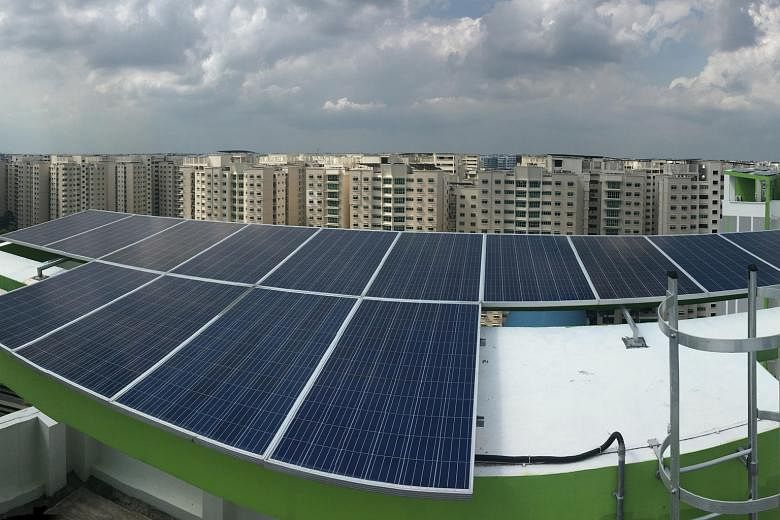It is unlikely that new HDB block rooftops, designed to make the installation of solar panels faster and cheaper, will translate to lower conservancy fees for residents any time soon.
Nevertheless, MPs and residents told The Straits Times that solar- ready rooftops - which the Housing Board announced yesterday would be incorporated into all new projects - are necessary in ensuring that Singapore's energy goals for the long run can be met.
Currently, 944 of Singapore's 10,000 HDB blocks have solar panels. HDB, which embarked on its solar capability journey in 2008, hopes to install panels on 5,500 blocks by 2020.
Mr Lim Biow Chuan, chairman of the Marine Parade Town Council, said the 110 blocks with solar panels in his GRC have resulted in some cost savings, though not significant enough to lower service and conservancy charges (S&CC).
This is because the bulk of a town council's funds still go to cleaning costs and lift maintenance, he said.
He added: "Of course, everyone wants lower fees. The question is whether it is sustainable to upkeep the estate in the long run. With so many lifts, I think it is quite difficult to do so."
Another reason conservancy fees are unlikely to come down is the cost of installing and maintaining solar panels.
While town councils do not bear the costs upfront - private developers of solar panels do - the capital outlay is substantial and will have to be recovered over time through selling excess electricity generated to the grid, said Nee Soon GRC MP and engineer Lee Bee Wah.
Under HDB's solar leasing model implemented in 2011, town councils purchase solar power generated by the panels at a rate not higher than the retail electricity tariff. Meanwhile, companies recover costs by selling the excess electricity that is not used to power common services like lights and lifts.
Excess solar energy enough to power about 10,000 four-room HDB flats is exported to the grid every month, HDB said.
Mr Ang Wei Neng, chairman of the Jurong-Clementi Town Council, pointed out that using more renewable energy sources would help slow down the rate of S&CC increases in the near term. The bulk of town councils raised their fees in June, with a second increase set to take place next year.
"The town council and residents benefit by not having to pay to light up the corridors and common areas, which are costs that can add up over the years," Mr Ang said.
By 2020, Singapore hopes to attain 350 megawatt peak, the maximum amount of solar power that can be generated under optimum conditions.
This means that, in theory, about 5 per cent of Singapore's energy needs can be met via solar energy. In reality, given the possibility of cloudy or rainy days, this would yield enough output to fuel only 1 per cent of the country's total energy consumption.
But the Government is looking beyond 2020 and at raising the adoption of solar power here to 1 gigawatt peak, through technological improvements and more panels, among other things.
Eco-Business managing editor Jessica Cheam noted that Singapore can achieve more on the solar capability front, especially as costs of installing panels decrease.
"Although the global economy - including Singapore's - is still reliant on fossil fuels in the short term, it is encouraging to see both the public and private sectors making efforts to accelerate the transition into renewable energy. It makes both economic and environment sense," she said.
The pilot for solar-ready roofs began at the six-block Punggol Edge, which resident Delson Lee welcomed. But he also hoped that any cost savings would be passed on to residents. "The cost savings may not be significant now, but we are talking about 20 years from now. Depending on how great the savings are eventually, I think residents should be entitled to rebates every one or two years," he said.


